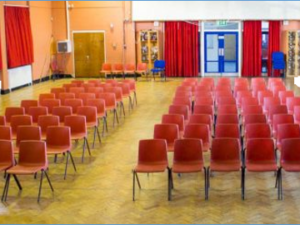Proportional Reasoning 1 (PR1)
Filling the Whole
Oliver said, “This assembly hall is 1% full”. Do you think he’s right?
Whether it’s filling an assembly hall or re-allotting seats on an airplane, Filling the Whole (PR1) helps students to make sense of percentage inside spatial arrays. By exploring scenarios in which objects can be moved around to complete columns and rows, two key mathematical strategies emerge: re-allotting and the bar model.
Easily accessible contexts—such as mobile phone batteries and photocopy machines—lead to the emergence of a double number or percentage bar. These models help students match percentages with relative quantities. Asking students, “What else do you know?”, encourages them to experiment with the flexibility and exploratory potential for this mode of problem solving. The power of the percentage bar model is fully exposed in the study of problems relating to savings accounts, best buys and percentage change. These contexts culminate in solving reverse percentage problems in a way that will make sense to learners of any age.
Overview of Filling The Whole
Section A: How Full?
Lessons 1: Filling Up
This is an introduction to percentages that ensures students develop images linked to fractions and percentages. In particular, it forces them to recognise when it is appropriate to focus on absolute and proportional amounts. Students are required to make visual representations of filling an array from one end.
Lesson 2: Multi-Storey Car Park
Here, emphasis is given to the importance of the whole when working with percentages. In Activity Sheet 2, students make comparisons between two different amounts that are represented by the same size bars. The reallotting strategy, introduced in the Fitting It In (N1) module is used here.
Section B: Percentages of Amounts
Lesson 3: The Photocopier
Students use the bar image from a photocopier to initially find fractions of an amount. They quickly move on to finding percentages of an amount. Students are asked to name parts of a whole in relation to the whole and the corresponding percentage. Some students will see the bar as a double number line, although this is not pursued until later in this unit.
Lesson 4: Battery Life
 Students look at the familiar context of battery life, enaging with benchmark percentages (0%, 10%, 20%, 25% etc.) in a visual manner. Students begin to use the bar in a more abstract way, although the context is kept ‘alive’ throughout. Problems involving more challenging percentage calculations are introduced.
Students look at the familiar context of battery life, enaging with benchmark percentages (0%, 10%, 20%, 25% etc.) in a visual manner. Students begin to use the bar in a more abstract way, although the context is kept ‘alive’ throughout. Problems involving more challenging percentage calculations are introduced.
Lesson 5: Saving Up
The context of a child saving for an Xbox is used to introduce the context of an interest paying savings account. The percentages used often require 1% to be found during the calculation and this strategy is introduced as an additional–but not exclusive–tool in their mathematical toolbox.
Lesson 6: Bargains
Students compare the sale price with the original price using percentages and make comparisons between deals by finding one number as a percentage of another.
Lesson 7: Sales
Questions about finding the original amount following either a percentage reduction or a percentage increase are introduced in context. The use of the percentage bar in previous lessons should give students immediate access to this concept and allow them to make sense of the required mathematical calculations.

More about RME landscapes.
Back to Our Materials.



